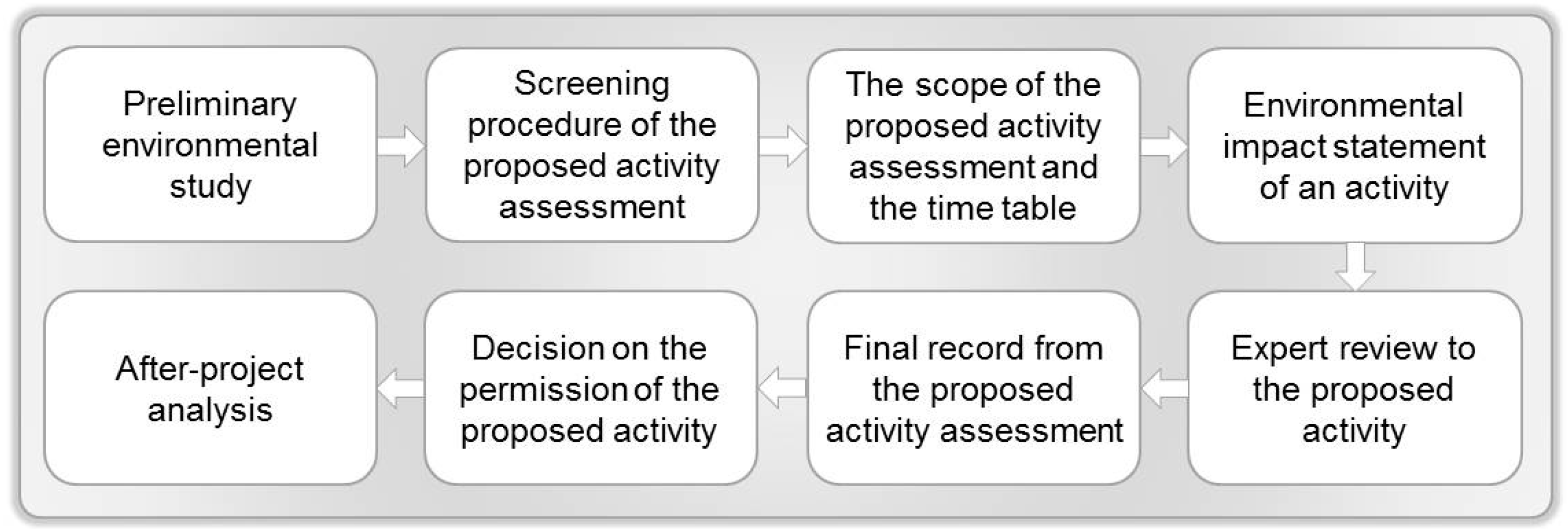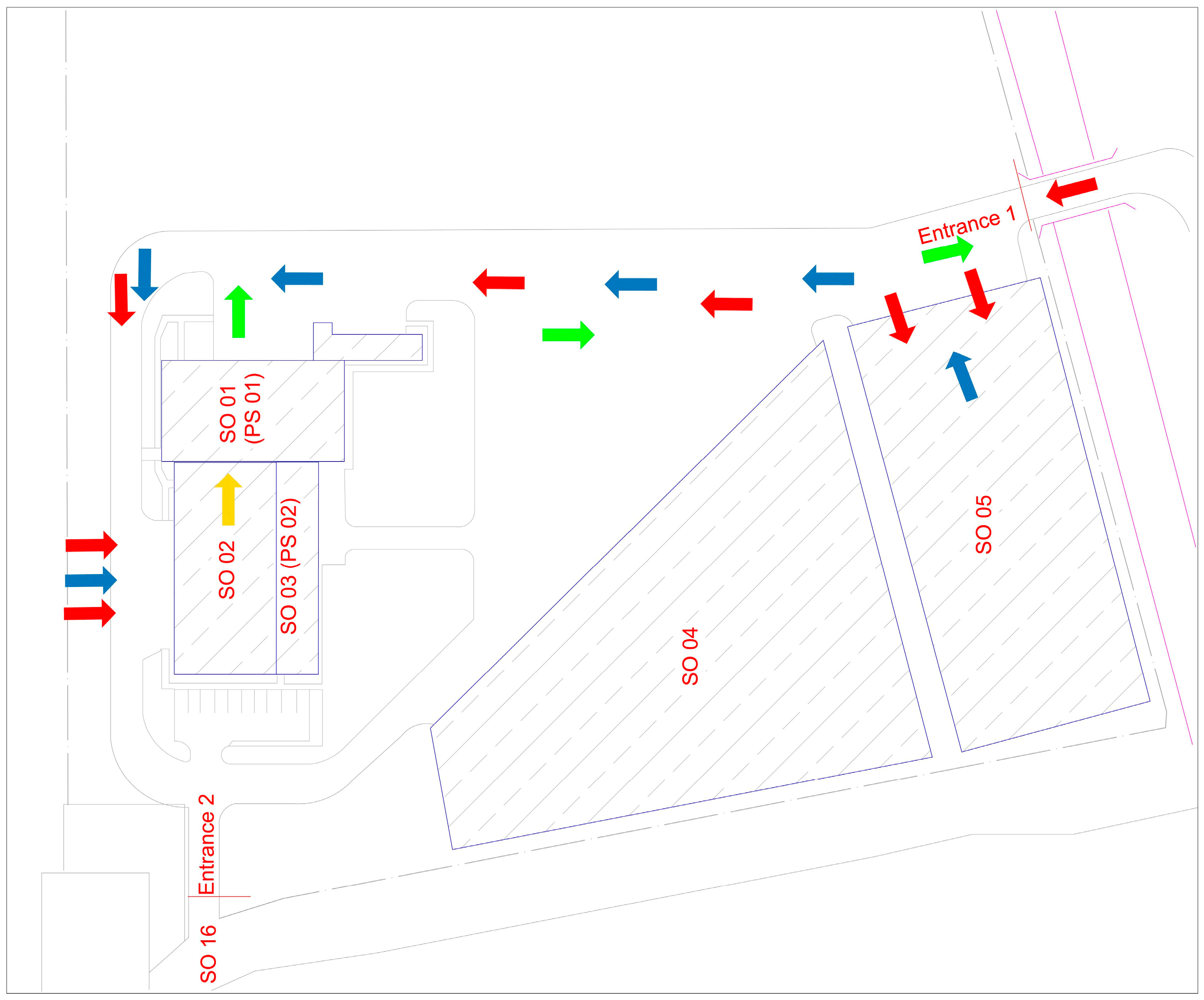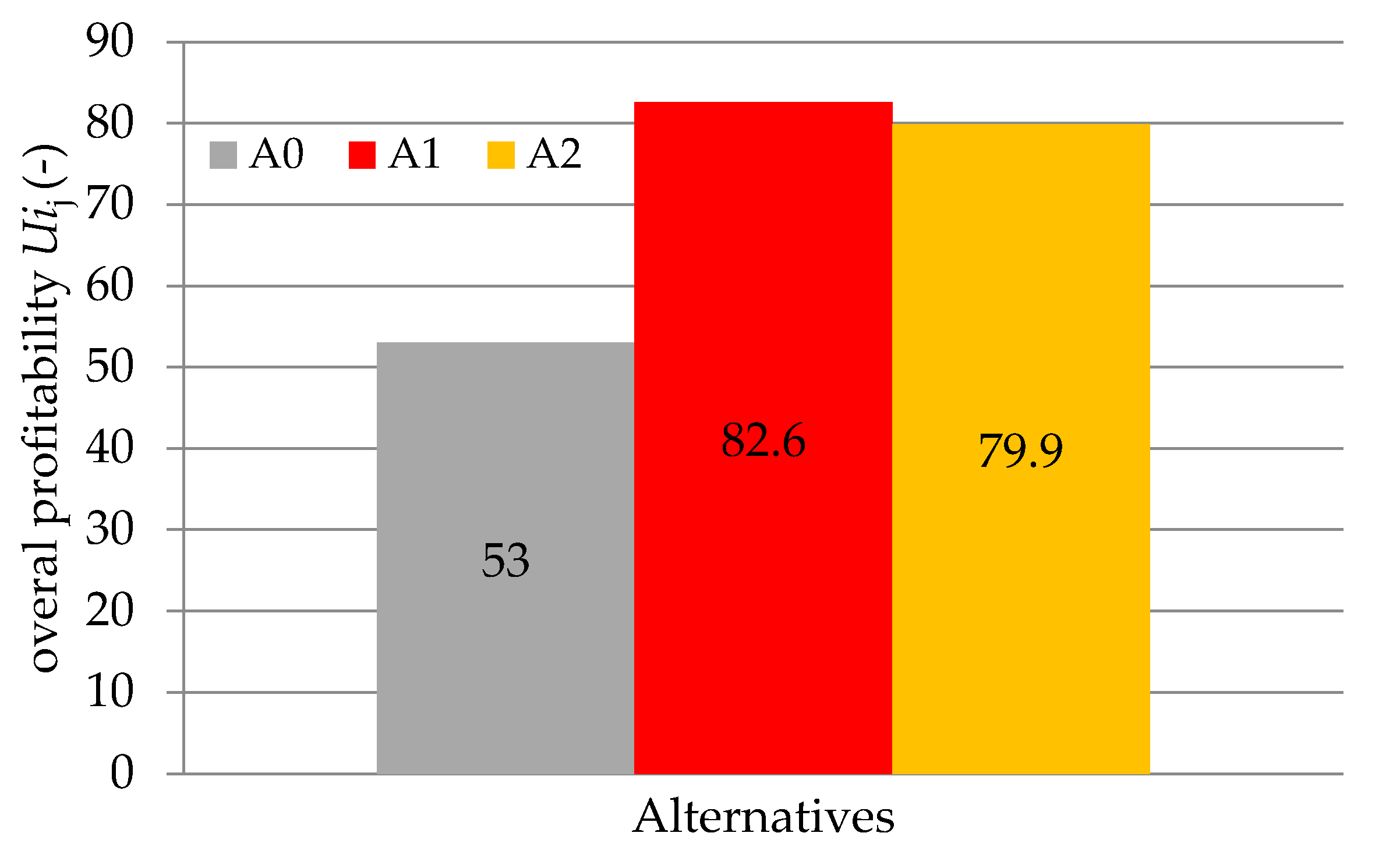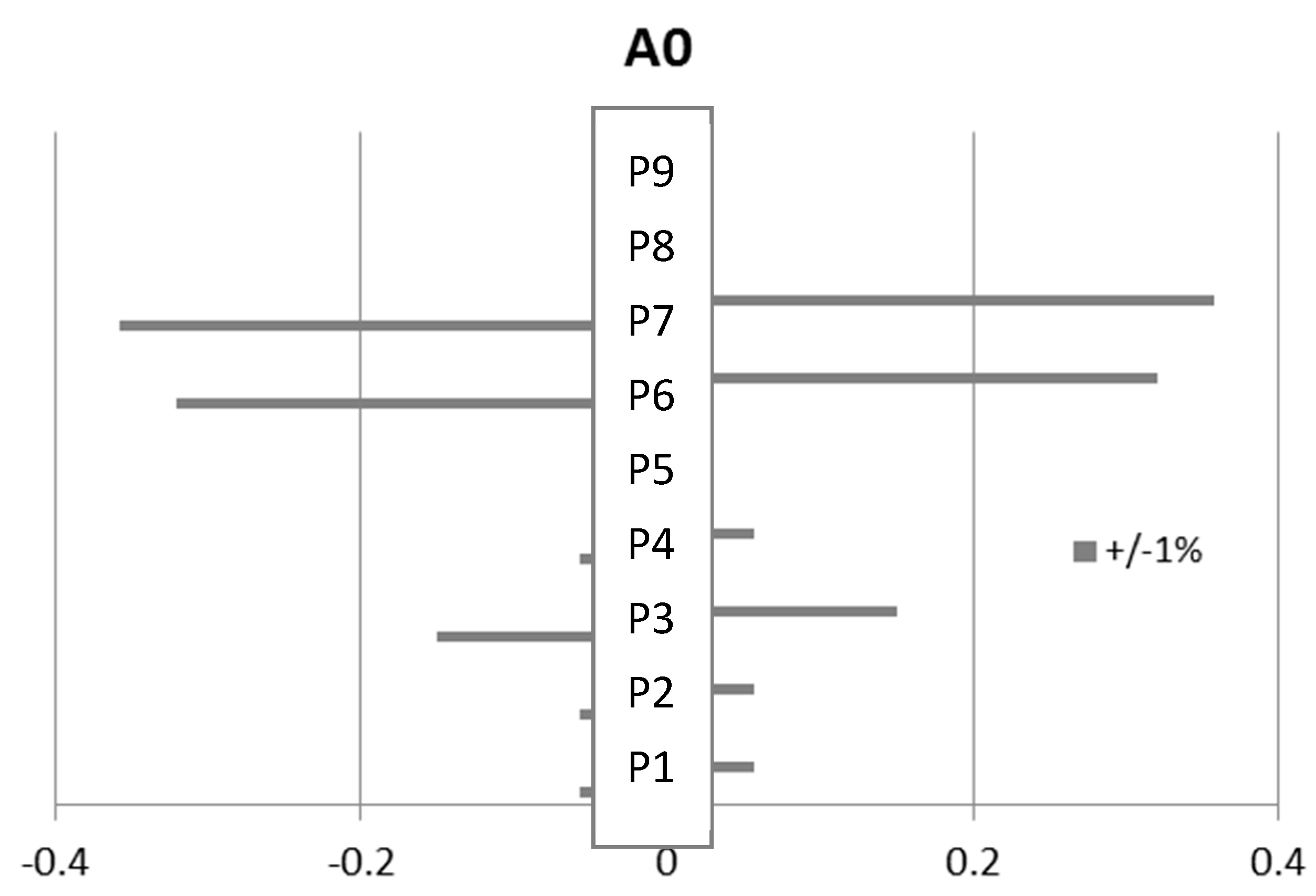Selection of the Best Alternative of Heating System by Environmental Impact Assessment—Case Study
Abstract
:1. Introduction
2. Materials and Methods
2.1. Description of the Study Area
2.2. Description of the Project
- biomass-fired power plant (alternative 1; wood chips and straw);
- modernization of existing natural gas boiler (alternative 2).
2.2.1. Biomass-Fired Power Plant
Wood Chips Combustion
Straw Combustion
2.2.2. Modernization of Existing Natural Gas Boiler
2.3. Application of the Methodology
- Scoping and impact identification techniques—these identify how and where an indirect or cumulative impact or impact interaction would occur—Network and analysis; Consultation and questionnaires; Checklists, Matrices; Expert opinion.
- Evaluation techniques—these quantify and predict the magnitude and significance of impacts based on their context and intensity—Matrices; Expert opinion.
- The creation of a purpose-oriented set of evaluation criteria;
- Setting the weights of the evaluation criteria;
- Assessment of the results (consequences, benefits, but also potential damages or losses of alternatives), it is a partial assessment of the alternatives;
- Assessment of the risks associated with implementing the alternatives;
- Determination of the preference order of alternatives and selection of the best option.
- (I)
- zero alternative—if there is no activity (current state of the environment); and
- (II)
- alternatives of the proposed activity—variants of the activity that usually differ in the locality (site of construction), used technology, time of implementation, etc.
- Ranking method
- Allocation method
- Grading method
- Pairwise comparison method
- Dual method ALO-FUL
3. Results and Discussion
- Alternative 0—the zero alternative—if no activity is implemented.
- Alternative 1—the biomass-fired power plant in Trebišov district.
- Alternative 2—modernization of existing natural gas boiler.
4. Conclusions
Author Contributions
Conflicts of Interest
References
- Slávka, Štroffeková. Energy and Its Environmental Impact Assessment in the Slovak Republic in 2011. The Indicator Sectoral Report. Available online: https://www.enviroportal.sk/uploads/spravy/sprava-ener-2013-final.pdf (accessed on 25 January 2018). (In Slovak).
- European Commision. Commission Staff Working Paper on Sustainable Industrial Development. Brussels, 25.10.1999, SEC(1999) 1729. Available online: http://ec.europa.eu/environment/archives/action-programme/pdf/sec991729_en.pdf (accessed on 9 December 2017).
- Directive 2001/77/EC of the European Parliament and of the Council of 27 September 2001 on the Promotion of Electricity Produced from Renewable Energy Sources in the Internal Electricity Market. Available online: https://publications.europa.eu/en/publication-detail/-/publication/9df8db5d-4776-4fcb-9077-4363e14b836a (accessed on 9 December 2017).
- Directive 2003/54/EC of the European Parliament and of the Council of 26 June 2003 Concerning Common Rules for the Internal Market in Electricity and Repealing Directive 96/92/EC—Statements Made with Regard to Decommissioning and Waste Management Activities. Available online: https://publications.europa.eu/en/publication-detail/-/publication/caeb5f68-61fd-4ea8-b3b5-00e692b1013c (accessed on 9 December 2017).
- Impact of Electricity Production on the Environment. Available online: https://online.sse.sk/portal/page/portal/stranka_SSE/spravy/ekologia (accessed on 30 November 2017). (In Slovak).
- Commission of the European Communities. Commission Staff Working Document. Accompanying Document to the Communication from the Commission to the Council and the European Parliament, Renewable Energy Road Map Renewable Energies in the 21st Century: Building a More Sustainable Future, Impact Assessment. Brussels, SEC (2006) 1719/2. Available online: http://www.ebb-eu.org/legis/renewable%20energy%20roadmap%20full%20impact%20assessment%20100107.pdf (accessed on 9 December 2017).
- Directive 2009/28/EC of the European Parliament and of the Council of 23 April 2009 on the Promotion of the Use of Energy from Renewable Sources and Amending and Subsequently Repealing Directives 2001/77/EC and 2003/30/EC (Text with EEA Relevance). Available online: http://eur-lex.europa.eu/eli/dir/2009/28/oj (accessed on 9 December 2017).
- Zvijaková, L.; Zeleňáková, M. Risk Analysis in Environmental Impact Assessment of Flood Protection Measures; Leges: Prague, Czech Republic, 2015. [Google Scholar]
- Kumar, S.; Katoria, D.; Sehgal, D. Environment Impact Assessment of Thermal Power Plant for Sustainable Development. Int. J. Environ. Eng. Manag. 2013, 4, 567–572. [Google Scholar]
- NTPC Limited. Environmental Impact Assessment Report for Tanda Thermal Power Project, Stage–II (2 × 660 mw); District-Ambedkar Nagar (UP), Document No.: 9562/999/GEG/S/001 Rev. No. 1; NTPC Limited: New Delhi, India, 2009. [Google Scholar]
- Pokale, W.K. Effects of thermal power plant on environment. Sci. Rev. Chem. Commun. 2012, 2, 212–215. [Google Scholar]
- Cigognetti, G.; Piccardim, M.; Vital, C. Ministero dell Ambiente e Della Tutela del Territorio e del Mare, Thermal Power Plant of Ponti sul Mincio—Conversion of the Chimney into Lookout Tower and Mincio Park Entrance as a Change to the Prescription of the EIA Screening Determination 2014. Available online: http://www.va.minambiente.it/en-GB/Oggetti/MetadatoDocumento/109647 (accessed on 3 January 2018).
- Coal Power Generation Comp any of Bangladesh Limited (An Enterprise of the People’s Republic of Bangladesh). Report on Environmental Impact Assessment of Construction of Matarbari 600X2 MW. 2013. Available online: https://libportal.jica.go.jp/library/Data/DocforEnvironment/EIA-EPC/EastAsia-SouthwesternAsian/ChittagongACFPPDP/BCEIA.pdf (accessed on 3 January 2018).
- Bo, X.; Wang, G.; Meng, F.; Wen, R. Air pollution effect of the thermal power plants in Beijing-Tianjin-Hebei region. China Environ. Sci. 2015, 35, 364–373. [Google Scholar]
- Sun, Y.; Liu, Y.; Liu, C. Environmental impact assessment on ambient air fine particulate matter PM2.5 role of prevention. J. Shenyang Jianzhu Univ. (Nat. Sci.) 2013, 29, 1147–1152. [Google Scholar]
- Enríquez-de-Salamanca, Á.; Martín-Aranda, R.M.; Díaz-Sierra, R. Consideration of climate change on environmental impact assessment in Spain. Environ. Impact Assess. Rev. 2016, 57, 31–39. [Google Scholar]
- Say, N.P.; Yücel, M.; Yilmazer, M. A computer-based system for environmental impact assessment (EIA) applications to energy power stations in Turkey: ÇEDINFO. Energy Policy 2007, 35, 6395–6401. [Google Scholar] [CrossRef]
- Moridi, F.; Atabi, F.; Nouri, J. Air Pollution Management based on the Selection of Appropriate Technologies for Air Pollutants Filtration using Multi-Criteria Decision-Making. An. Acad. Bras. Cienc. 2015, 87, 314–323. [Google Scholar]
- Shah, A.; Salimullah, K.; Sha, M.H.; Razaulkah, K.; Jan, I.F. Environmental impact assessment (EIA) of infrastructure development projects in developing countries. OIDA Int. J. Sustain. Dev. 2010, 1, 47–54. [Google Scholar]
- Directive 2014/52/EU of the European Parliament and of the Council of 16 April 2014 on the Assessment of the Effects of Certain Public and Private Projects on the Environment. 2014. Available online: http://ec.europa.eu/environment/eia/pdf/EIA_Directive_informal.pdf (accessed on 25 January 2018).
- National Council of the Slovak Republic 2005 Act of Law No. 24/2006 from December 14th 2005 on Environmental Impact Assessment and on Amendments to Certain Acts. Available online: http://www.ujd.gov.sk/files/legislativa/145_2010_EN.pdf (accessed on 25 January 2018).
- Zeleňáková, M.; Zvijáková, L. Using Risk Analysis for Flood Protection Assessment; Springer: Cham, Switzerlandm, 2017; p. 128. [Google Scholar]
- Trebisovksa Energeticka Inc. Central Energy Source of Trebisov; TM-P-114.13-B, Technical Report—Summary; Trebisovksa energeticka Inc.: Trebisov, Slovakia, 2013. (In Slovak) [Google Scholar]
- Olejník, A. Environmental Impact Assessment of Construction. Master’s Thesis, Technical University of Kosice, Košice, Slovakia, 6 May 2016. [Google Scholar]
- Maphil.com, Free Satellite Location Map of Rad. Available online: http://www.maphill.com/slovakia/kosice/trebisov/location-maps/satellite-map/ (accessed on 30 November 2017).
- Slámková, M.; Garčárová, M. Encouraging the Protection of Natura 2000 Sites in Integrating Whole-System of Ecological Stability. Regional Territorial System of Ecological Stability of the Trebišov District. 2012. Available online: www.minv.sk/?verejne-vyhlasky-7&subor=207452 (accessed on 30 November 2017). (In Slovak).
- Ivaň, M. Mechanisms for Recovery of Wastes of Category “O” Others, Recovery of Construction Debris, Paper, Plastics, Wood,” Company Trebišov Town, LAND—Service 2011. Enviroportal.sk, Information Portal of MoE SR. Available online: http://www.enviroportal.sk/sk_SK/eia/detail/ing-michal-ivan-land-servis-trebisov-zariadenie-na-zhodnocovanie-odpad (accessed on 30 November 2017). (In Slovak).
- Banik and Son Inc. Differences between Traditional and Condensing Boilers. 2015. Available online: http://www.banik.sk/rozdiely-medzi-klasickym-a-kondenzacnym-kotlom/ (accessed on 30 November 2017). (In Slovak).
- Durikova, K. How Does Condensing Boiler Works? Bratislava: JAGA Group. 2013. Available online: http://mojdom.zoznam.sk/cl/10055/1351440/Oplati-sa-investovat-do-plynoveho-kondenzacneho-kotla- (accessed on 30 November 2017). (In Slovak).
- Canter, L.W. Methods for Effective Environmental Information Assessment (EIA) Practice. In Environmental Methods Review: Retooling Impact Assessment for the New Century; Porter, A.L., Fittipaldi, J.J., Eds.; The Press Club: Fargo, ND, USA, 1998. [Google Scholar]
- Canter, L.W. Environmental Impact Assessment. In Environmental Engineers’ Handbook; Liu, D.H.F., Lipták, B.G., Eds.; CRC Press: Boca Raton, FL, USA, 1999. [Google Scholar]
- Kozova, M.; Drdos, J.; Pavlickova, K.; Uradnicek, S. Environmental Impact Assessment; Comenius University in Bratislava: Bratislava, Slovakia, 1996. [Google Scholar]
- Walker, L.J.; Johnston, J. Guidelines for the Assessment of Indirect and Cumulative Impacts as well as Impact Interactions. 1999. Available online: http://ec.europa.eu/environment/archives/eia/eia-studies-and-reports/pdf/guidel.pdf (accessed on 25 January 2018).
- Lawrence, D.P. Environmental Impact Assessment: Practical Solutions to Recurrent Problems, 2nd ed.; John Wiley & Sons: Hoboken, NJ, USA, 2013. [Google Scholar]
- Říha, J. Environmental Impact Assessment. Methods for Preliminary Decision Analysis; ČVUT: Praha, Czech Republic, 2001. (In Czech) [Google Scholar]
- Říha, J. Environmental Impact Assessment of Investments; Multicriteria Analysis and EIA; Academia: Prague, Czech Republic, 1995. [Google Scholar]
- Majerník, M.; Húsková, V.; Bosák, M.; Chovancová, J. Methodology of the Environmental Impact Assessment; Technical University of Košice (TUKE): Košice, Slovakia, 2008. [Google Scholar]
- Gałaś, S.; Kroł, E. Indicators for environmental-spatial order assessment on the example of the Busko and Solec Spa communes. Gospodarka Surowcami Miner.-Miner. Resour. Manag. 2008, 24, 95–115. [Google Scholar]
- Zelenakova, M.; Ondrejka Harbulakova, V.; Olejnik, A. Using of Multicriteria Method for Choosing the Best Alternative of the Heating Power Plant, Selected Scientific Papers. J. Civ. Eng. 2017, 12, 47–56. [Google Scholar]
- Kampf, R. Estimation Methods for Weight Criteria. Sci. Pap. Univ. Pardubice B 2003, 9, 255–261. [Google Scholar]









| Group of Methods | Methods |
|---|---|
| Recommended methods suitable for preliminary impact study | Ad hoc methods |
| Checklists and catalogues of criteria | |
| Tables and matrices, expressing the causes and the effects | |
| Networks and system diagrams | |
| Decision trees | |
| Overlay mapping | |
| Recommended methods suitable for environmental impact statement | Prognostic methods
|
| Multicriteria analysis | Method of utility function |
| Total Environmental Quality Indicator (TIEQ) method | |
Methods for determining weights of criteria
|
| Aspect | Economic | Technical | Ecological | Social |
|---|---|---|---|---|
| Criteria (Pi) | the total cost of construction (P1) | time of construction (P3) | waste production (P6) | job opportunities (P8) |
| annual operation cost (P2) | land occupation (P4) | emissions production (P7) | extra boiler room construction (P9) | |
| energy outputs of the power plants (P5) | ||||
| Character of assessment | quantitative | quantitative | qualitative | qualitative |
| Criteria Pi/ Alternative Ai | P1 | P2 | P3 | P4 | P5 | P6 | P7 | P8 | P9 | ∑Uj | |
|---|---|---|---|---|---|---|---|---|---|---|---|
| bv | 9 | 8 | 10 | 8 | 9 | 8 | 7 | 9 | 8 | ||
| wi | 3 | 3 | 8 | 3 | 11 | 17 | 19 | 17 | 19 | 100 | |
| A0 | value | 0 € | 0 € | 0 months | 0 m2 | 0 MW | no | 0% | 0 | yes | |
| points | 9 | 8 | 10 | 8 | 0 | 8 | 7 | 0 | 0 | ||
| ki0 | 1 | 1 | 1 | 1 | 0 | 1 | 1 | 0 | 0 | ||
| ki0.wi | 3 | 3 | 8 | 3 | 0 | 17 | 19 | 0 | 0 | 53 | |
| A1 | value | 3.8 mil. € | 0.54 mil. € | 9 months | 2000 m2 | 14 MW | yes | 0% | 8 | no | |
| points | 3 | 6 | 2 | 3 | 9 | 5 | 7 | 9 | 8 | ||
| ki1 | 0.33 | 0.75 | 0.2 | 0.375 | 1 | 0.625 | 1 | 1 | 1 | ||
| ki1.wi | 0.99 | 2.25 | 1.6 | 1.125 | 11 | 10.63 | 19 | 17 | 19 | 82.6 | |
| A2 | value | 2.6 mil. € | 0.65 mil. € | 3 months | 1250 m2 | 10 MW | yes | 6.5% | 6 | no | |
| points | 8 | 5 | 8 | 6 | 8 | 4 | 6 | 7 | 8 | ||
| ki2 | 0.88 | 0.625 | 0.8 | 0.75 | 0.88 | 0.5 | 0.86 | 0.78 | 1 | ||
| ki2.wi | 2.64 | 1.875 | 6.4 | 2.25 | 9.68 | 8.5 | 16.3 | 13.26 | 19 | 79.9 | |
© 2018 by the authors. Licensee MDPI, Basel, Switzerland. This article is an open access article distributed under the terms and conditions of the Creative Commons Attribution (CC BY) license (http://creativecommons.org/licenses/by/4.0/).
Share and Cite
Ondrejka Harbulakova, V.; Zelenakova, M.; Purcz, P.; Olejnik, A. Selection of the Best Alternative of Heating System by Environmental Impact Assessment—Case Study. Environments 2018, 5, 19. https://doi.org/10.3390/environments5020019
Ondrejka Harbulakova V, Zelenakova M, Purcz P, Olejnik A. Selection of the Best Alternative of Heating System by Environmental Impact Assessment—Case Study. Environments. 2018; 5(2):19. https://doi.org/10.3390/environments5020019
Chicago/Turabian StyleOndrejka Harbulakova, Vlasta, Martina Zelenakova, Pavol Purcz, and Adrian Olejnik. 2018. "Selection of the Best Alternative of Heating System by Environmental Impact Assessment—Case Study" Environments 5, no. 2: 19. https://doi.org/10.3390/environments5020019
APA StyleOndrejka Harbulakova, V., Zelenakova, M., Purcz, P., & Olejnik, A. (2018). Selection of the Best Alternative of Heating System by Environmental Impact Assessment—Case Study. Environments, 5(2), 19. https://doi.org/10.3390/environments5020019






